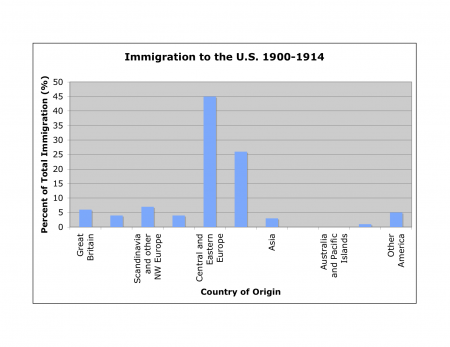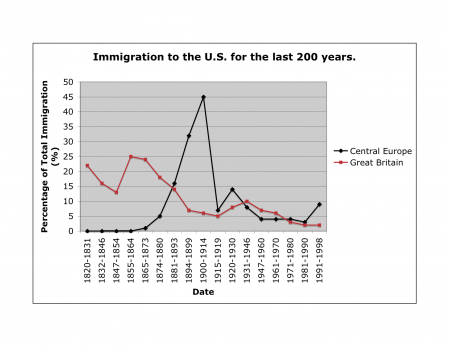We had presentations on current immigration issues today, and, just coincidentally, NPR had an article on the lead singer of Bright Eyes taking political stands against laws like Arizona 1070.
Tag: immigration
U.S. Immigration Data
Raymond Cohn has a great table of immigration data on the Economic History Association website.
This data ties very nicely into the work we’re doing on graphing. The Excel file with the post 1820 data, and another with pre-1790 data, make it easier to work with (note the pre-1970 data comes from the Wikipedia page on the history of immigration; it was the easiest source to find a table of data).
Since each small group of students is responsible for a different wave of immigration, the groups will create bar graphs showing the countries of origin for each wave. They should look like these:

and,

Plotting the time series as a line graph would be another great way to slice the data:

Note that the data in the table is as a percentage of total immigration, so the numbers do not compare directly from one time period to the next; however, the proportions still work to show the same patterns.
North American English Dialects

Linguist, Rick Aschmann, has wonderfully detailed maps of the various dialects of English used in North America. It includes lots of audio samples of speech, and is excellently annotated.
Given that dialects are great integrators of cultural history, including the history of immigration to the different regions, this may well be an excellent resource for this cycle’s work on U.S. immigration.
The r-dropping areas in the Lowland South … could be described as “Classical Southern”. This is the accent that Scarlett O’Hara is attempting to imitate in this clip from Gone with the Wind. This area represents the heart of the old plantation system, as can be seen on the map mentioned above. However, this feature seems to only occur in older settled areas, and does not occur in western areas on the Mississippi River or farther west that were settled after about 1825.
— from American English Dialects by Aschmann, (2010).
Songs from the East Village
When sorting through the many issues around immigration and globalization it is nice to be able to highlight the small things that make it seem worthwhile.
The East Village Community School in New York City is selling a CD, as an arts fundraiser, of songs performed by its students. The songs and musicians have roots that span the globe, from Mauritius to Tibet to Spain to Ireland to name just a few.
The CD in $15 and you can order it from the School’s website.
NPR’s Weekend Edition had a nice article on the parent driven project: